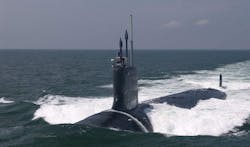L3Harris KEO to build electro-optical photonics masts to aid stealth of Virginia-class attack submarines
WASHINGTON – U.S. Navy undersea warfare experts are enhancing the stealthiness and survivability of the nation's premiere fast-attack submarine fleet by equipping additional vessels with improved electro-optical sensor photonics masts.
Officials of the Naval Sea Systems Command in Washington announced an $17.3 million order last week to L3Harris KEO (formerly Kollmorgen Electro-Optical) in Northampton, Mass., to build the Low Profile Photonics Mast (LPPM).
The LPPM aboard Navy Virginia-class attack submarines operates in place of the traditional submarine periscope. The photonics mast uses a variety of electro-optical sensors, and does not penetrate the submarine hull like a traditional periscope. Instead, photonics mast sensors connect to the submarine by optical fiber.
The LPPM is a low-observable optical mast that reduces the submarine's risk of detection by enemy submarines and surface warships while the system is in use, while improving the submarine's sensor capability.
Related: Navy orders additional submarine electro-optical imaging sensors from Lockheed Martin
The LPPM is a modular non hull-penetrating imaging sensor sited in a telescoping universal modular mast bay that provides the submarine with improvements in stealth and survivability. Imagery from the LPPM is displayed on high-definition screens aboard the submarine.
Features include short-wave infrared (SWIR) and high-definition visual imaging, laser range finding, special stealth features, and an antenna suite with broad spectral coverage and direction finding. SWIR sensors particularly are adept at penetrating fog, haze, and other obscurants.
In March 2019 L3Harris KEO $8.7 million order to build LPPM units. Five years ago L3Harris won an $111.8 million contract to develop LPPM prototypes. At the time Navy Chief of Naval Operations Adm. Jonathan Greenert asked for all Pacific Fleet Virginia-class submarines to be equipped with the LPPM to support sensitive missions vital to national security.
Related: L-3 to provide electro-optical submarine sensor systems for U.S. attack and missile boats
LPPM prototypes initially were developed without the installation and spares necessary to support deployments and were intended only for integration and testing as part of local operations, Navy officials say.
Production LPPM masts were not to be made available until 2018. Previous to that, LPPM prototypes were installed on deploying Virginia-class submarines as one way to provide fast LPPM capability.
On this order L3Harris KEO will do the work in Northampton, Mass., and should be finished by February 2022. For more information contact L3Harris KEO online at https://www2.l3t.com/keo, or Naval Sea Systems Command at www.navsea.navy.mil.
